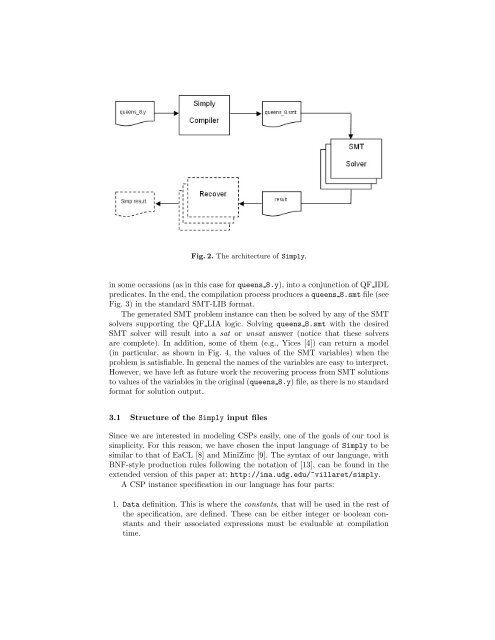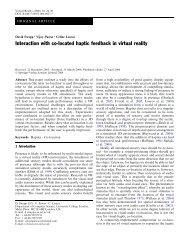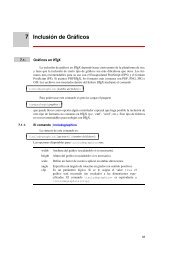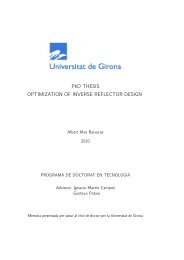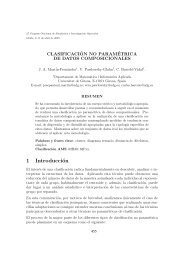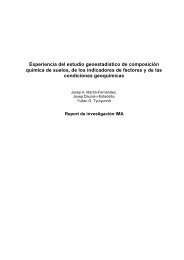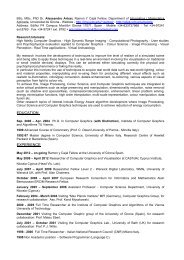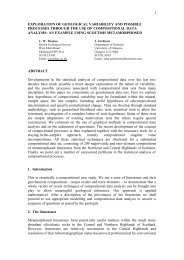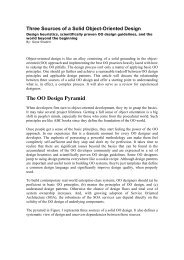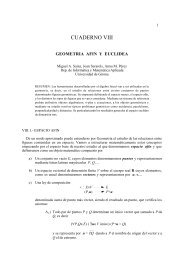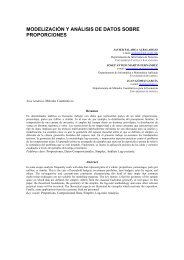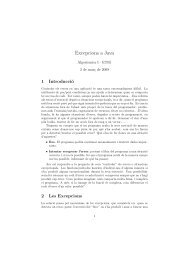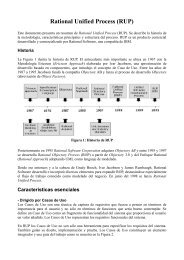idea is making <strong>the</strong> DPLL(X) engine and Solver Twork in cooperation: while<strong>the</strong> DPLL(X) engine is in charge of enumerating (partial) propositional models,Solver Tis responsible for checking whe<strong>the</strong>r <strong>the</strong>se models are consistent with <strong>the</strong>given <strong>the</strong>ory T (for example, if T is <strong>the</strong> <strong>the</strong>ory of Linear Integer Arithmetic and<strong>the</strong> current boolean model contains x + 2y ≤ 0, −y − z ≤ 0 and x − 2z > 1, <strong>the</strong>nSolver Thas <strong>to</strong> detect that <strong>the</strong> current boolean assignment is T -inconsistent).Notice that Solver Tonly needs <strong>to</strong> handle conjunctions of literals <strong>from</strong> <strong>the</strong>ory T .In this way, given a formula F and a <strong>the</strong>ory T , we are determining whe<strong>the</strong>r <strong>the</strong>reis a model of T ∪ {F }.Current <strong>SMT</strong> solvers can deal with several <strong>the</strong>ories and logics. For <strong>the</strong> purposesof our <strong>to</strong>ol, as we explain in Section 3, <strong>the</strong>re are two logics which are especiallyrelevant, namely, quantifier free Integer Linear Arithmetic (QF LIA) andits fragment Integer Difference Logic (QF IDL). QF LIA formulas are booleancombinations of inequations between linear polynomials over integer variables.QF IDL formulas are boolean combinations of inequations of <strong>the</strong> form x − y < bwhere x and y are integer variables and b is an integer constant (see [13] fordetails). Such a<strong>to</strong>ms occur in <strong>the</strong> definition of feasible solutions for many problems.For instance, <strong>the</strong>y can be used <strong>to</strong> express constraints on <strong>the</strong> time elapsedbetween pairs of events. Since <strong>the</strong> satisfiability of conjunctions of difference logicliterals can be reduced <strong>to</strong> <strong>the</strong> absence of negative cycles in finite weighted graphs,it can be decided in O(n 3 ) time by <strong>the</strong> Bellman-Ford algorithm. For this reason,many solvers give a special treatment <strong>to</strong> such kind of literals.3 Simply: The <strong>to</strong>olIn this section we describe <strong>the</strong> input language and features of Simply throughan example. Let us consider <strong>the</strong> n-Queens problem: given a number n of queensof <strong>the</strong> chess game, <strong>the</strong> problem is <strong>to</strong> find a position in a board of size n × n,for each queen, such that no queen threatens any o<strong>the</strong>r (i.e., <strong>the</strong>y are not in <strong>the</strong>same column, row or diagonal). A naive model of <strong>the</strong> n-Queens problem (forn = 8) in <strong>the</strong> Simply input language can be found in Fig. 1, with an array q ofn integer variables where q[i], for i in 1..n, denotes <strong>the</strong> row where <strong>the</strong> queenof column i is placed. The problem is solvable iff <strong>the</strong>re exists an assignment forq, according <strong>to</strong> its domain, such that all <strong>the</strong> posted constraints are satisfied, i.e.,all <strong>the</strong> values of q are different (i.e., no two queens are in <strong>the</strong> same row) and <strong>the</strong>distances between <strong>the</strong> indexes (columns) and values (rows) of any two pair ofelements of <strong>the</strong> array are distinct (i.e., no two queens are in <strong>the</strong> same diagonal).In Fig. 2 <strong>the</strong> architecture of Simply is depicted throughout <strong>the</strong> process ofcompiling and solving <strong>the</strong> 8-Queens problem. Let <strong>the</strong> input of <strong>the</strong> compiler be <strong>the</strong>queens 8.y file of Fig. 1. In <strong>the</strong> compilation process all constants are replaced by<strong>the</strong>ir associated value, and all variables are translated in<strong>to</strong> <strong>SMT</strong> integer variables.Constraining a variable <strong>to</strong> its domain results in a disjunction of equalities when<strong>the</strong> domain is an explicit enumeration of values, or in<strong>to</strong> a conjunction of twoinequality predicates when <strong>the</strong> domain is described as a range. The translationof <strong>the</strong> constraints typically results in<strong>to</strong> a conjunction of QF LIA predicates and,
Fig. 2. The architecture of Simply.in some occasions (as in this case for queens 8.y), in<strong>to</strong> a conjunction of QF IDLpredicates. In <strong>the</strong> end, <strong>the</strong> compilation process produces a queens 8.smt file (seeFig. 3) in <strong>the</strong> standard <strong>SMT</strong>-<strong>LIB</strong> format.The generated <strong>SMT</strong> problem instance can <strong>the</strong>n be solved by any of <strong>the</strong> <strong>SMT</strong>solvers supporting <strong>the</strong> QF LIA logic. Solving queens 8.smt with <strong>the</strong> desired<strong>SMT</strong> solver will result in<strong>to</strong> a sat or unsat answer (notice that <strong>the</strong>se solversare complete). In addition, some of <strong>the</strong>m (e.g., Yices [4]) can return a model(in particular, as shown in Fig. 4, <strong>the</strong> values of <strong>the</strong> <strong>SMT</strong> variables) when <strong>the</strong>problem is satisfiable. In general <strong>the</strong> names of <strong>the</strong> variables are easy <strong>to</strong> interpret.However, we have left as future work <strong>the</strong> recovering process <strong>from</strong> <strong>SMT</strong> solutions<strong>to</strong> values of <strong>the</strong> variables in <strong>the</strong> original (queens 8.y) file, as <strong>the</strong>re is no standardformat for solution output.3.1 Structure of <strong>the</strong> Simply input filesSince we are interested in modeling <strong>CSP</strong>s easily, one of <strong>the</strong> goals of our <strong>to</strong>ol issimplicity. For this reason, we have chosen <strong>the</strong> input language of Simply <strong>to</strong> besimilar <strong>to</strong> that of EaCL [8] and MiniZinc [9]. The syntax of our language, withBNF-style production rules following <strong>the</strong> notation of [13], can be found in <strong>the</strong>extended version of this paper at: http://ima.udg.edu/~villaret/simply.A <strong>CSP</strong> instance specification in our language has four parts:1. Data definition. This is where <strong>the</strong> constants, that will be used in <strong>the</strong> rest of<strong>the</strong> specification, are defined. These can be ei<strong>the</strong>r integer or boolean constantsand <strong>the</strong>ir associated expressions must be evaluable at compilationtime.


